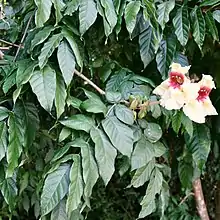| Markhamia stipulata | |
|---|---|
 | |
| Markhamia stipulata, Hainan, China | |
| Scientific classification | |
| Kingdom: | Plantae |
| Clade: | Tracheophytes |
| Clade: | Angiosperms |
| Clade: | Eudicots |
| Clade: | Asterids |
| Order: | Lamiales |
| Family: | Bignoniaceae |
| Genus: | Markhamia |
| Species: | M. stipulata |
| Binomial name | |
| Markhamia stipulata | |
| Synonyms[1] | |
| |
Markhamia stipulata (Thai: แคหัวหมู or แคป่า, khae hua mu or khae pa; Chinese: 西南猫尾木, xi nan mao wei mu) is a species of plant in the family Bignoniaceae. It is native to South China and Southeast Asia.[2][3] This species usually grows as a tall tree, reaching heights of 5–15 m. Stipulata thrives in sparsely treed areas, such as fields. Flowers are pale yellow to reddish brown.[4]
Uses
The flower is edible and is part of both Lao cuisine[5] and Thai cuisine, where it is known as Dok Khae Hua Mu or Dok Khae Pa. The flowers are usually eaten sauteed or in Kaeng som. The leaves are also used in traditional Thai medicine.[6]
 Khae pa flowers
Khae pa flowers Sauteed khae pa flowers
Sauteed khae pa flowers
See also
- Sesbania grandiflora, known as ดอกแค dok khae in Thai
- Edible flower
- List of Thai ingredients
References
External links
 Media related to Markhamia stipulata at Wikimedia Commons
Media related to Markhamia stipulata at Wikimedia Commons Data related to Markhamia stipulata at Wikispecies
Data related to Markhamia stipulata at Wikispecies
This article is issued from Wikipedia. The text is licensed under Creative Commons - Attribution - Sharealike. Additional terms may apply for the media files.